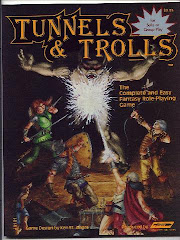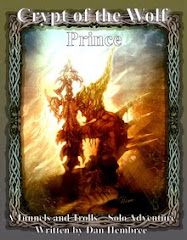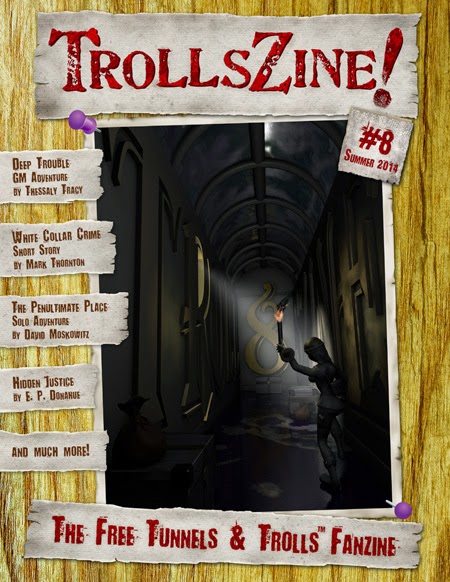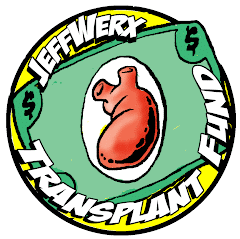 |
| I think he's mad at me. |
Listed below are the five "standard" nonhuman kindred for T&T. I've given the dT&T attribute modifiers for each kindred followed by my own changes to those modifiers to provide some balance. Positive modifiers are highlighted in Blue; negative modifier in Red. Any modifiers that I changed are in Bold.
Dwarves
STR 2 CON 2 DEX 1 SPD 1 LK 0.75 IQ 1 WIZ 1 CHR 1
Dwarves have significant increases to STR and CON and only a minor reduction in LK. With two attributes being increased, I decided two should be reduced. Since dwarves had a reduced CHR in 5th edition and a reduced LK in 7th edition, I thought the combination of these two attributes was best. I kept the positive modifiers to STR and CON as they were and adjusted negative modifiers to LK and CHR to balance them out.
STR 2 CON 2 DEX 1 SPD 1 LK 0.5 IQ 1 WIZ 1 CHR 0.5
Revised dwarves are just as strong and hearty, but somewhat unlucky and surly.
Elves
STR 1 CON 0.67 DEX 1.33 SPD 1 LK 1 IQ 1.5 WIZ 1.5 CHR 1.5
Four of eight attributes get positive modifiers at the cost of reducing CON by 3/4. That's quite a deal. The reduction in CON does balance out the increase in DEX, but obviously CON cannot be reduced further to compensate for the x1.5 boost to IQ, WIZ, and CHR. Since elves are meant to be less robust than humans in terms of CON, I also gave them a reduced STR. I also removed the positive CHR modifier because, let's face it, not everyone is enamored with elves.
STR 0.5 CON 0.7 DEX 1.4 SPD 1 LK 1 IQ 1.5 WIZ 1.5 CHR 1
Revised elves retain their extra intellect, magical potency, and agility (slightly enhanced), but tend to be physically weaker in terms of brawn and health.
Fairies
STR 0.25 CON 0.25 DEX 1.75 SPD 1 LK 1.5 IQ 1 WIZ 2 CHR 1.5
Fairy modifiers are actually pretty well balanced. They have big reductions in STR and CON making them fragile, but good boosts to DEX, LK, WIZ, and CHR. Despite their apparent weakness, however, with the Adds generated from DEX and LK fairies can decimate the opposition with missile fire. Their lethality is only increased by the loss of negative Adds in dT&T. Plus, you know, they can fly.
STR 0.25 CON 0.25 DEX 1.5 SPD 1 LK 1.5 IQ 1 WIZ 2 CHR 1.5
Overall I am happy with the fairy modifiers. My modified fairies only have a slightly reduced boost to DEX to make up for the loss of negative adds.
Hobbs
STR 0.5 CON 2 DEX 1.5 LK 1.5 IQ 1 WIZ 1 CHR 1
Hobb are fairly weak, but are quite robust as well as agile and lucky. The boosts to DEX and LK give Hobbs a lot of extra Adds and their lack of STR is more than made up for by their high CON.
STR 0.5 CON 2 DEX 1.5 LK 1.5 IQ 0.75 WIZ 0.75 CHR 1
Revised hobbs have all the great boons of normal hobbs, but tend to be not quite as bright and less in tune with magic than other kindred.
Leprechauns
STR 0.33 CON 0.67 DEX 1.5 LK 1.5 IQ 1.25 WIZ 1.5 CHR 1
Leprechauns represent a nice balanced build in my opinion. They are physically weaker and less robust than humans but have slightly better agility, luck, intelligence, and magical aptitude to make up for it. No changes required here.
Character Example
Let's take a sample character and see how it looks cast as the various standard kindred from dT&T. Attributes that are positively affected by modifiers are in Blue; those that are negatively modified are in Red. Rolling 3D6 in order we get:
Human
STR 11 CON 10 DEX 16 SPD 14 LK 10 IQ 10 WIZ 13 CHR 9
Level: 1
Adds: +6
Dwarf (Standard)
STR 22 CON 20 DEX 16 SPD 14 LK 8 IQ 10 WIZ 13 CHR 9
(Total Attribute Increase: 21)
(Total Attribute Decrease: 2)
Level: 2
Adds: +16
Elf (Standard)
STR 11 CON 7 DEX 21 SPD 14 LK 10 IQ 15 WIZ 20 CHR 14
(Total Attribute Increase: 22)
(Total Attribute Decrease: 3)
Level: 2
Adds: +11
Fairy (Standard)
STR 3 CON 3 DEX 28 SPD 14 LK 15 IQ 10 WIZ 26 CHR 14
(Total Attribute Increase: 35)
(Total Attribute Decrease: 15)
Level: 2
Adds: +21
Hobb (Standard)
STR 6 CON 20 DEX 24 SPD 14 LK 15 IQ 10 WIZ 13 CHR 9
(Total Attribute Increase: 23)
(Total Attribute Decrease: 5)
Level: 2
Adds: +17
Leprechaun (Standard)
STR 4 CON 7 DEX 24 SPD 14 LK 15 IQ 13 WIZ 20 CHR 9
(Total Attribute Increase: 23)
(Total Attribute Decrease: 10)
Level: 2
Adds: +17
The ratio of attribute increase to decrease varies from 10.5:1 (dwarves) to 2.3:1 (fairies and leprechauns). Dwarves and Elves really are the uber-characters of the bunch with Hobbs as a close third. Neither Dwarves nor Elves have any real disadvantages. Hobbs at least have a low STR to go along with their high CON, DEX, and LK. The Fairy and Leprechaun both have low STR and CON that make them fragile to help balance out their many other advantages. In addition, all of the nonhuman kindred start off as Level 2 characters with all of the advantages associated with their Type. The human will need to acquire a minimum of 700 Adventure Points to gain those advantages. The nonhumans also start with 2 to almost 4 times the Personal Adds of the human. This difference has really been accentuated by the removal of "negative adds" generated by key attributes with values less than 9 in dT&T. Cuts in STR, for example, used to keep adds in check for certain kindred like fairies, hobbits, and leprechauns.
Now let's look at my modified kindred. The attributes that have been affected by the changes are in bold.
Human
STR 11 CON 10 DEX 16 SPD 14 LK 10 IQ 10 WIZ 13 CHR 9
Level: 1
Adds: +6
Dwarf (Modified)
STR 22 CON 20 DEX 16 SPD 14 LK 5 IQ 10 WIZ 13 CHR 5
(Total Attribute Increase: 21)
(Total Attribute Decrease: 9)
Level: 2
Adds: +16
Elf (Modified)
STR 6 CON 7 DEX 22 SPD 14 LK 10 IQ 15 WIZ 20 CHR 9
(Total Attribute Increase: 18)
(Total Attribute Decrease: 8)
Level: 2
Adds: +12
Fairy (Modified)
STR 3 CON 3 DEX 24 SPD 14 LK 15 IQ 10 WIZ 26 CHR 14
(Total Attribute Increase: 31)
(Total Attribute Decrease: 15)
Level: 2
Adds: +17
Hobb (Modified)
STR 6 CON 20 DEX 24 SPD 14 LK 15 IQ 8 WIZ 10 CHR 9
(Total Attribute Increase: 23)
(Total Attribute Decrease: 10)
Level: 2
Adds: +17
Leprechaun (Unmodified)
STR 4 CON 7 DEX 24 SPD 14 LK 15 IQ 13 WIZ 20 CHR 9
(Total Attribute Increase: 23)
(Total Attribute Decrease: 10)
Level: 2
Adds: +17
Even with the modifications, the nonhumans still come out in better shape than humans (start as 2nd level, 2-3x the Adds), but all have some key disadvantages associated with one or two low attributes even if they do not affect personal adds. The resulting affect on Saving Rolls will certainly be critical (that's one unlucky dwarf). Importantly, the attribute increase to decrease ratio for each of the kindred is now approximately 2.3:1. That seems much more reasonable in my opinion. I'm anxious to play test these new kindred to see how they work out in an actual game.










